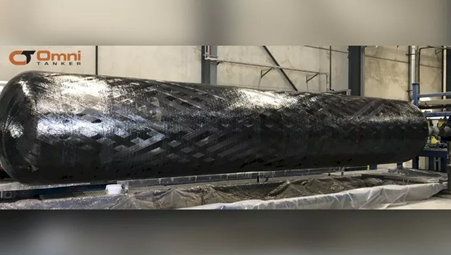Through close partnership with Lockheed Martin and Australian manufacturer Omni Tanker, a UNSW Sydney team led by Professor Chun Wang at the School of Mechanical and Manufacturing Engineering has developed world-first composite tank technologies for the transportation and storage of liquid hydrogen at minus 253 degrees Celsius on a commercial scale.
A key challenge in the storage of liquid hydrogen on a large scale has been the formation of matrix cracks, a challenge that has, up until now, prevented mass-market adoption of these materials for such applications.
“This new technology is the result of an outstanding collaboration and partnership between UNSW, Lockheed Martin and Omni Tanker over the past four years. It is wonderful seeing our research achievement is now moving closer towards commercial success and generating social and economic impact in Australia and beyond,” said Professor Wang who leads the UNSW research team.
This co-funded project is thanks to a $1.4 million grant from the Federal Government’s Advanced Manufacturing Growth Centre (AMGC) to create Australian technologies to address the challenges regarding using composites for the transportation and storage of liquid hydrogen. These applications will allow hydrogen to be stored on ground, in the air, underwater and in space.
“Creating a lightweight vessel for transporting liquid hydrogen at minus 253 degrees Celsius is no simple thing – whether you’re moving it along a highway or to outer space – but it’s Australian know-how that is making it possible,” said Dr Jens Goennemann, Managing Director at AMGC.
Nano-engineering technology developed by UNSW in partnership with Lockheed Martin and Omni Tanker’s OmniBIND™ technology would be used to develop two new operational scale propellant tanks: a “Type IV” fluoropolymer-lined carbon fibre composite tank and a “Type V” linerless carbon fibre composite tank, designed for the extreme cryogenic temperatures required for storing cryogenic liquid fuels for commercial and civil satellite programs.
These composite tanks will be lightweight, cost-effective, and resistant to microcracking and permeation and will showcase the cutting-edge technology of composite pressure vessel manufacturing.
“These advances have the potential to support the growth of Australia’s sovereign space capabilities, strengthen exports to space-faring allies and partner nations, and make an important technological contribution to future space missions particularly in on-orbit storage, launch and deep space exploration,” said David Ball, Regional Director for Australia and New Zealand, Lockheed Martin Space.
Christopher Hess, Head of Industrial Development at Lockheed Martin Australia, said: “We have had a long-standing research collaboration with UNSW and Omni Tanker, and we are grateful for the support of the AMGC as we now look to commercialise these cutting-edge, Australian-developed composite tank technologies for a number of Lockheed Martin and NASA applications.”
In the near future, the collaboration also aims to integrate thermoplastic lining technology in the aerospace sector using OmniBIND™ technology to ensure safe and efficient movement of challenging liquids within the chemical transport sector.
“Now the growing need to decarbonise the energy industry, and the re-usable low-Earth orbit satellite market, have the potential to drive major utilisation for these new technologies,” said Daniel Rodgers, CEO of Omni Tanker.

